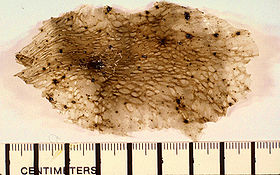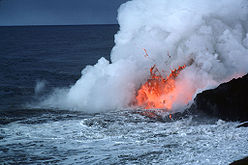
Limu o Pele
Encyclopedia

Hawaiian language
The Hawaiian language is a Polynesian language that takes its name from Hawaii, the largest island in the tropical North Pacific archipelago where it developed. Hawaiian, along with English, is an official language of the state of Hawaii...
, literally, "seaweed of Pele", after Pele
Pele (mythology)
In the Hawaiian religion, Pele is the goddess of fire, lightning, wind, and volcanoes. She is a popular figure in many stories of ancient Hawaii known as Hawaiian mythology.-Legends:...
the Hawaiian fire goddess of volcano
Volcano
2. Bedrock3. Conduit 4. Base5. Sill6. Dike7. Layers of ash emitted by the volcano8. Flank| 9. Layers of lava emitted by the volcano10. Throat11. Parasitic cone12. Lava flow13. Vent14. Crater15...
es) is a geological term for thin sheets and subsequently shattered flakes of brownish-green to near-colourless volcanic glass
Volcanic glass
Volcanic glass is the amorphous product of rapidly cooling magma. Like all types of glass, it is a state of matter intermediate between the close-packed, highly ordered array of a crystal and the highly disordered array of gas...
lava
Lava
Lava refers both to molten rock expelled by a volcano during an eruption and the resulting rock after solidification and cooling. This molten rock is formed in the interior of some planets, including Earth, and some of their satellites. When first erupted from a volcanic vent, lava is a liquid at...
spatter that commonly resemble seaweed
Seaweed
Seaweed is a loose, colloquial term encompassing macroscopic, multicellular, benthic marine algae. The term includes some members of the red, brown and green algae...
in appearance, that have been erupted from a volcano
Volcano
2. Bedrock3. Conduit 4. Base5. Sill6. Dike7. Layers of ash emitted by the volcano8. Flank| 9. Layers of lava emitted by the volcano10. Throat11. Parasitic cone12. Lava flow13. Vent14. Crater15...
. Limu o Pele is formed when water is forced into and trapped inside lava, as when waves wash over the top of the exposed flows of the molten rock. The water boils and is instantly converted to steam, expanding to form bubbles within the lava. The lava rapidly cools and solidifies as the bubbles grow. The volcanic glass bubbles burst and are dispersed by the wind, showering flakes of glass downwind.
Limu o Pele has been found around subaerial littoral volcanic cones and also at submarine volcano
Submarine volcano
Submarine volcanoes are underwater fissures in the Earth's surface from which magma can erupt. They are estimated to account for 75% of annual magma output. The vast majority are located near areas of tectonic plate movement, known as ocean ridges...
es, for example, on the summit of Lōʻihi
Loihi Seamount
Lōihi Seamount is an active undersea volcano located around off the southeast coast of the island of Hawaii about below sea level. It lies on the flank of Mauna Loa, the largest shield volcano on Earth...
seamount
Seamount
A seamount is a mountain rising from the ocean seafloor that does not reach to the water's surface , and thus is not an island. These are typically formed from extinct volcanoes, that rise abruptly and are usually found rising from a seafloor of depth. They are defined by oceanographers as...
.


